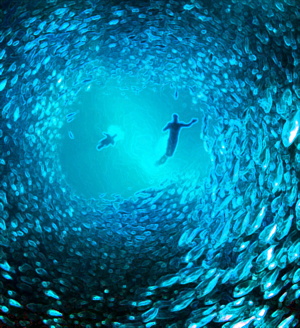|
La Isla Bonita(continued) By Dean Borok On our last full day of snorkeling in Cozumel, Magpie and I went to Playa Paraiso, just north of the cruise ship terminal, which we know from previous trips to be a real hotbed of sea life. The cruise ship pier being under repair from the ravages of Wilma, the ships, huge, immaculate floating hotels with names like Pearl of the Caribbean, were moored at sea right in front of us. At the side of each ship's hull, near the waterline, was a solitary little door were the shuttle launches would pull up to disembark cruise passengers and bring them to shore for a day of sightseeing. You expect passengers of huge ships like these to disembark down a big gangplank at a dock, so seeing ferries pull up to this little side door was a bit incongruous. Anyway, what interested Magpie and me was what was teeming beneath the surface, not what was going on above it. We adjusted our masks and snorkels and jumped in. You're immediately transported to another planet. Floating above this world in the clear, warm water you soon forget that you're in water at all, and it is like flying through the air at the top of an atmosphere whose inhabitants are also flying a few feet beneath you, as though you were flying in the air above the birds. That is what makes exploring sea life so fascinating, an extra vertical dimension not found on dry land. One wonders what our culture would be today if the ancient inhabitants had had access to that mundane object we take for granted today: the sealed diving mask. Of course, the engineering expertise it takes to fit a glass lens to a rubber mask that forms a vacuum around your eyes and nose has only been perfected in the last century. Prior to that, people could only gaze over the water's surface and speculate on what took place beneath. If previous civilizations, with their great sculptors and painters, had had access to this simple instrument, the mask, might not our world today reflect more of that which takes place over 90 percent of its surface? Would not our architecture reflect the inspiration of coral formations, our clothing and interiors mimic the shimmering, gaudy reflections of the deep? Would not the epic poetry of the ancient Greeks and Romans have recounted mythic adventures that took place beneath the ocean's surface, our religious deities portrayed as gods residing in magnificent undersea palaces? Unfortunately, now that we have the tools to study these heretofore forbidden regions, the masks, scuba tanks and undersea vessels, we have not the artistic inspiration or curiosity to bring them into our cultural realm. Magpie and I found what we were looking for: what had once been a huge school of silver fish that resided in these waters. On previous visits, we had been astounded by the size of the school — millions of fish, a carpet of them, stretching hundreds of meters. This immense megalopolis was an astonishing sight, and we wanted to see it again before returning to New York. Unfortunately, this swim brought home to us a more graphic understanding of the damage Wilma had effected on the marine environment than had any of our previous excursions. The huge school of fish had been completely decimated. Where once millions upon millions of fish lived, they were now reduced to a small group of perhaps several thousands. All those millions of fish gone! It would take years for the school to return to its former size. People see the surface effects of the hurricane, Magpie had kept insisting, without giving any thought to the damage done to the marine life by the seismic churning of the sea. The stupendous magnitude of the damage was incontrovertible, yet what was left of the school behaved eerily like nothing had gone amiss. What that school of fish does there, I couldn't possibly imagine. It had been there for years that we knew of, and never broke ranks, even to hunt for food. Was it in the path of a current of microscopic algae and could just sit there as its food was brought to it? The shimmering reflection of the sunlight on the fish's scales reminded me of what Magpie had told me about barracuda confusing my sparkling gold chain for a fish, and now I came to really conceptualize the logic of that. What marvel of intelligence or communication causes fish to gather in the millions, to instantly separate and regroup as though by instantaneous thought transference, swimming back on themselves and forming a complex and intricate geometric ballet, forming kaleidoscopic patterns of visual enchantment? Might it not be indicative of a collective wisdom formed by billions of years of evolution? Who says that fish are stupid? People have never given any thought to submarine intelligence except in dolphins who are, after all, mammals, and therefore more comprehensible to us, but who knows what thoughts or wisdom are locked in the mind of a fish? People are generally conditioned to think of fish as dumb corpses packed on ice in a Chinatown stall, but I have had occasion to look into the eyes of many a live fish in his own natural environment and have discerned from those experiences a lively intelligence and curiosity. They have not hands to construct, or a spoken language, but who can imagine the thoughts, memories and emotions that might be trapped inside them, that might obsess them? We came across a huge eagle ray, a monstrous spotted creature at least
ten feet across, with a barbed tail at least twelve feet long. His face,
impassive and pensive, was eerily humanoid. He stared as us for a moment
without curiosity, and then fluttered his bat-like wings at us, as though
to bid us adieu, before swimming out to sea. |
